Archery can be quite a fun activity to practice to improve both your physical and mental readiness. But for you to maximize both your enjoyment and skill some level of information needs to be known about archery equipment.
One of those information is knowing what arrows to use with a recurve bow. Here is a list of the best ones that match your needs:
- Easton XX75 Jazz Aluminum Arrows.
- Hunting-door Carbon Arrows with Field Points.
- E-ROCK 500 Carbon Archery Arrows.
- Hunting-door 12 Pcs Turkey Feather.
- MS Jumpper Archery Carbon Arrows.
Best Recurve Bow Arrows
Easton Genesis V2 Arrows
As always, Easton designing team made sure to provide their loyal customers with another reliable & affordable product.
The product comes as a set of 6 aluminum arrows. different types of spines are available to suit a larger range of weight bows and length requirements. The build quality is quite good and is able to take a lot of abuse & damage.
Even though we didn’t have this problem, We noticed some people talking about not receiving the same color that they ordered so keep that in mind when buying these ones.
After taking everything into consideration, If you don’t care about the how your arrows look and just want some good & affordables arrows for your recurve bow, The Easton Genesis V2 Arrows are your best bet.
Pros:
- Trueflight Parabolic Feathers.
- Steel Tips + Replaceable Nocks.
- Great For Novice Archers.
- Bow Weight Between 15 lb to 50lb.
- Can’t handle extensive use.
Hunting-door Carbon Arrows with Field Points
Switching to one of the most well known type of arrows, carbon fiber arrows which are used by the bulk of modern archers. The reason for that is thanks to their extremely lightweight material.
Very high quality field tips with the nocks glued in a correct way. Meaning they are aligned with the odd colored fletching so it passes through my tri-pattern brush arrow rest correctly, and sits right on the string.
All the fletching is in the correct spot. The aluminum pieces on the tip of the arrow come out fairly easily. Just pulling the arrows out of a simple bag style target has pulled a few of the tips all the way out.
On the other hand, The arrows are a little bit too stiff to be used with a light bow so if you are working with a lightweight bow, These arrows are probably not for you.
Overall, For that price point, I would say they are have a good durability to them and flies well.
Pros:
- Improved Wall Thickness.
- Replaceable Tips
- Low Hand Shock & Good Speed.
- Draw Weight Of 40-55 Pounds.
- Nocks could be better.
M Musen 500 Carbon Archery Arrows
Targeted more around the target practice market, The Musen carbon arrows are one of the most lightweight products you will find today that still provides amazing performance & an premium feel to it.
Works great for both beginners that are just learning archery and expert hunters than need something that does the job properly. The build quality is quite sturdy and durable and the tips are nickel plated stainless steel that will be able to last through more abuse than regular wooden arrows, and better yet, are far cheaper.
The shaft is not as stiff as expected, but for light draw weights, they work just fine. And comes with a replaceable fletching, nocks that can be adjusted for your bow and a couple of hunting arrowheads.
Now even though their main purpose is for target practice, You will still be able to do some small game hunting such as squirrel hunting…etc.
Pros:
- High Quality Pure Carbon Fiber Build.
- Nickel-Plated Stainless Steel Tip.
- Great For Practice.
- Can Handle Extensive Use.
Cons:
- Flight path could use improvements.
Hunting-door 12 Pcs Turkey Feather
Out of the box these arrows seem like the top notch. They feel very traditional in your hands and look a lot more impressive than modern arrows. Very handsome fletching, and solid knocks, but the adhesive on the string wrapping is weak and starts to unravel after a few days of shooting.
The feathers claim to be pheasant feathers but feel a little bit fake after some investigation, It might be due to the fact they used some kind of glue or hardening compound to stick them together.
After firing them a few times they started to feel like natural feathers but I’m still not sure. That being said, they do cut up your bow hand.
Pros:
- Hand Spined.
- Pre-Cut & Ready To Shoot.
- Spine Weight 40 lbs to 60lbs.
Cons:
- Durability could be better.
MS Jumpper Archery Carbon Arrows
Made for two specific reasons, Target shooting and hunting. These particular arrows are easily one of the lightest available on the market of today.
The build quality is surprisingly durable, They come with replaceable screw-in stainless steel field points which gives them a more versatile, 4-inch of real feather, and a carbon fiber shaft.
They also have a very low shock to the hand & a fairly good speed to them. When testing them, These carbon arrows seem to fly straight up and penetrate the deep inside of the target.
Pros:
- Good Performance.
- Low Hand Shock + Good Speed.
- Extra Durable.
- Draw Weight Up To 65 Pounds.
Cons:
- The nocks aren’t as tight as they should be.
why and How to pick the best recurve bow arrow for you
The reason you should do your best to pick arrows that suit you and your body structure is: Safety and Precision/Precision.
Choosing an arrows that is too heavy for you might not let your shoots reach your target, On the other hand if you pick an arrows that’s too weak will most likely make your flight projectile suffer.
In archery, The term arrow spine is the referring to the element that controls the flight performance of your arrow. It’s a measure of the arrow’s stiffness or flexibility.
The best arrow spine should be 3 things:
- Type/kind of bow.
- Draw length.
- Draw weight.
Since we are talking about recurve arrows, We only need to be focusing on the draw length and weight.
How to calculate your draw length
There are two ways you can calculate your draw length, The first one is:
1st Method: Arm Span Measurement
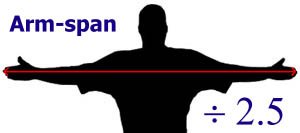
With this method you will need someone to help you hold the measuring tape.
- Spread out your arms at shoulder level.
- Have the other person measure the length from fingertip to fingertip.
- Divide the length of your arm span by 2.5.
For example, your arm span measurement is 70 inches. (70 in. ÷ 2.5 = 28 in. ← Draw Length)
2st Method: Wall Measurement
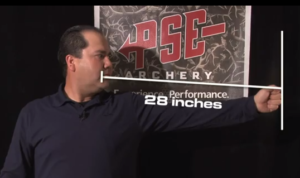
This one also does requires another person to help you with measuring your arm but you can also measure it by yourself.
- Stand and face the wall sideways.
- Put the fist of your bow arm on the wall. This should mimic your stand when you’re holding a bow.
- turn your head and look at the wall.
- Let your friend or family member measure the distance from the wall up to the corner of your mouth.
And that is your draw length.
How to calculate your draw weight
Calculating your draw weight will be one of the deciding factor on how good you are in archery.
As a Beginners who have never shot an arrow before, You should always start with the lowest, then work their way up as they progress in training and practice.
The draw weight generally means the maximum amount an archer can pull while drawing a bow.
We came up with a chart that shows you the suggested draw weight based on the your frame and weight. But in the end you should still try to start from the lowest number and rise it as you go on.
Archery won’t be fun if the bow is too hard to pull. Apart from that, it’s not good for your shoulders, joints, and muscles.
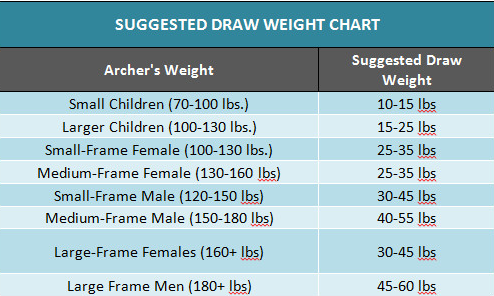
If the archer has never pulled a bow before, start with the lowest draw weight, 10 pounds.
After a couple of weeks of constant practice, and once the muscles have gone used to pulling such heavy weights, you can add more weight and power.
The Absolute Charts To Archery Recurve Bow Arrows Selection
Now that you have calculated your draw length, draw weight and have an idea about arrow weight, you can now determine your arrow spine and shaft size.
Let’s take a look at the Easton Arrow Length Chart for Recurves. Here’s a snapshot from their guide:

Here is another one that is more general and these numbers are based on a 100 gr. point, if you use a 125 gr. point you may need to use a stiffer spine if you use a 85 gr. point you may need to use the weaker spine.
Recuve bow parts
The recurve bows and compound bows are made up of different parts, as mentioned if it is a take-down bow then these can be dismantled. There are many different parts that can be purchased and added at a later stage to help with your archery such as sights and stabilizer. These are completely natural and not needed to become good at archery.
The main parts that you will find on all recurve bows are;
1. The Riser
The riser is crucial when it comes to the recurve bow. You can find it in the center of the bow between the limbs. If you were to use any accessories such as sights then they will connect to the riser (as long as it has the holes available). Originally they were made from wood, however aluminium is becoming more common due to them being lighter. You can also find carbon fiber risers that again are even lighter.
The grip is a part of the riser and is where you would be holding the bow. The grip is very important as you want it to fit your hand naturally and feel comfortable. They can often be replaced, allowing you to find one that you like. To be honest, I have never had a issue with the ones supplied with the recurve bows I have brought.
2. The Limbs
At either end of the riser are the limbs, these are flexible wood or in many cases fiberglass or carbon fiber. It is these that when the string is pulled stores and then releases kinetic energy needed to fire the arrow at your target. Many limbs are manufactured following a common standard, this means that you don’t always have to stick to the same manufacture for limbs as the riser its connected to.
As you begin experienced with archery and your strength increases, you may upgrade the limbs to ones that have higher pressure and more weight.
3. Arrow Rest
Old bows people would have rested the arrow on the hand that was gripping the bow, now recurve bows have what’s known as the arrow rest. This is usually plastic or in some cases metal and is where the arrow rests whilst you draw the bow.
4. Bow String
The bow string is attached to both of the limbs and is what you naturally need to pull back with the arrow attached, releasing this releases the stored energy which then shoots the arrow. The bow string needs to be fully drawn in order to get the most of your shot.
Common Questions
The Archery Guide gets a few questions about the different types of bows, below are the most common questions asked about the recurve bow.
Can I Buy and Shoot a Bow Right Away?
More than often it will need you to string the bow and tune it, there are many guides to help do this and at first it might seem scary it is actually easier than it sounds.
How Much Should I Spend On My First Bow?
You don’t want to spend too much on your first bow as you will outgrow it very quickly. The best beginner bows are usually around $100-$200 and these are perfect for just starting out, some of them will take you further if you do upgrade the limbs.
Which Bow Manufacture Is Best?
There are some great recurve bow brands and I would always recommend getting your bow from one of these well-known manufactures. You know that the bow is going to be made of quality and will last a lot longer than some cheap knock off. Brands that are recommended are Bear, Samick, PSE and Hoyt – although there are others.
How Big Of A Bow Should I Get?
The larger bows do tend to be more accurate when you shoot, so many hunters tend to go for something a bit bigger but this does depend on transporting it etc. The length of the bow should be around double your draw length.
Can I Shoot My Recurve Bow In My Garden?
It will vary from country to country but it is completely legal to shoot your recurve bow in your garden. You do need to be careful and take full responsibility that the arrows remain in your garden.
I really hope this guide has helped you find the best recurve bow for you, whether you are a beginner, or experienced. Its really important to know what to look for and I hope this has shine a light on a typically though choice.
Conclusion: What arrows to use with a recurve bow
As you can see, Recurve bow itself is such a broad topic that have many aspect for you to become fully efficient with it. But that does not mean you can’t be an archer without it.
We hope you enjoyed our complete guide on what What arrows to use with a recurve bow. If you have anything you would like to ask about archery feel free to leave a comment down below.






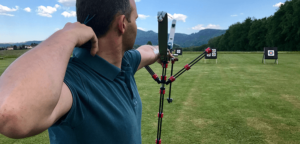
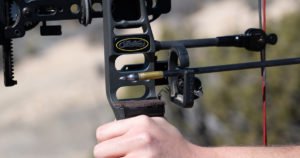
![Read more about the article Best Bow Stabilizer For Target Shooting [Perfect Accuracy]](https://valrin.com/wp-content/uploads/2019/05/target-shooting-300x225.jpg)